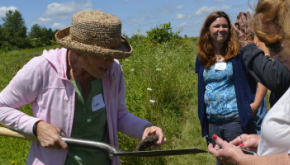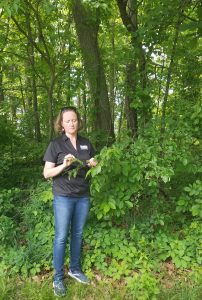
This article appeared in the National Association of Conservation Districts' newsletter.
Indiana’s LaPorte County Soil and Water Conservation District (SWCD) is partnering with Women4theLand to focus on female landowner needs through periodic Women’s Conservation Learning Circles.
“The American Farmland Trust did some research that found when women find themselves in a position where they’ve inherited property or have lost their husbands, they are more likely to hang on to the property and manage it in a more consistent way with their values when they have direct access to resources,” SWCD Education Coordinator Nicole Messacar said.
“We have a lot of forests and a lot of female landowners, so we wanted to have a stronger connection with them,” she said. “This has been very successful, and we will be doing it again.”
The first gathering took place in June at Cummings Lodge in LaPorte and included about 20 female landowners, as well as representatives from the Natural Resources Conservation Service (NRCS), Indiana Department of Natural Resources, the County Surveyor’s Office and other local resource professionals.
Morning discussions examined how female landowners can connect with local resource professionals. After lunch, there was a guided hike that included invasive species identification and forest management practices. The hike also included information on efforts to promote healthy soil and water quality and information on financial assistance programs.
“They’re all concerned about maintaining the quality of their forest,” Messacar said. “Everyone had a different reason for participating – one landowner was a birder, another was concerned about invasive species – but forest health was at the top.”
The smaller group size allowed the women to interact with one another, share stories and suggestions, and provide the SWCD with suggestions on topics for additional workshops.
Messacar found that key takeaways included learning which agencies were available to help and in which areas of their land management process. It’s something she plans to build upon for future workshops.
“It really did engage them. I don’t want to lose that,” she said. “They had a lot of great questions.”
Already, landowners have contacted the conservation district to schedule a time for a forester or conservationist to visit their property, and in some cases, to provide ideas for land management. Messacar noted that the local NRCS district conservationist also experienced an increase in inquiries.
Messacar will soon decide on potential topics for future meetings.
“This approach is different for me in that the women are saying, ‘Yes, tell me more,’ so we’re letting it play out in order for us to learn what our women need, so we can meet them there,” she said.

